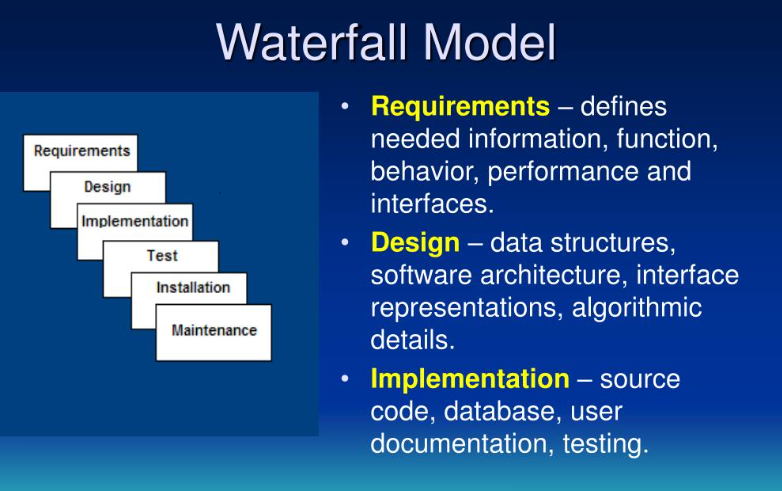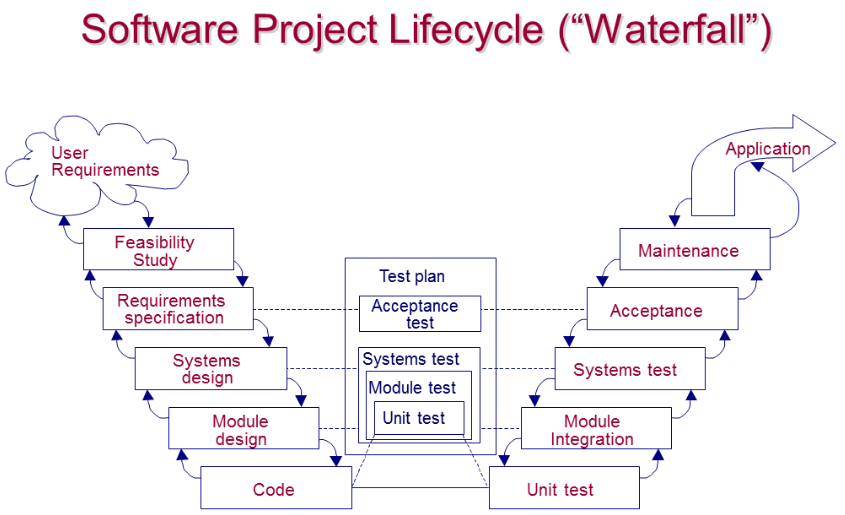Understanding the Waterfall Model in Software Development
A conventional technique for developing software that uses a linear and sequential process is called the “Waterfall Model.” It was one of the earliest models used in the software industry and is characterized by its well-defined phases and rigorous structure. The model is named “waterfall” because the development process proceeds downward through a succession of discrete phases, comparable to water streaming down a waterfall.
Phases of the Waterfall Model
During the waterfall development process, a succession of phases, each of which has its own consequence, are done. Business analysts undertake requirements analysis, which entails generating a specification document containing all the system requirements. From a corporate and regulatory point of view, the business analyst captures all features, functions, and operational procedures of the system. Another project stakeholder, often from the company, signs off on this document.
It is followed by system design, which entails examining the requirements and establishing a system design. A technical team, comprising developers and architects, specifies how the system will be created. As soon as the system design step is complete, developers create code to implement the system. In the integration and testing phase, a team of testers brings all system components together and tests them independently.

Once the testing team has finished their work and signed off on the system as fit and suitable, the solution is ready for deployment to end customers. After deployment into production, the solution proceeds through a maintenance phase, during which faults are addressed, tested, and redeployed into production. The choice may be taken to restart the waterfall process if the repairs are large; however, this might take a long time and is not ideal for urgent fixes.
Core Phases and Characteristics
Requirements Gathering and Analysis:
In this phase, the project’s requirements are collected and analyzed in detail. This involves comprehending the client’s requirements, expectations, and specifications for the software product.
System Design:
Once the requirements are compiled, the software’s architecture and system design are planned. This includes delineating the software’s structure, components, modules, and their relationships. The design phase creates a blueprint for the software solution.
Implementation (Coding):
The design from the previous phase is used to develop the actual code for the software. Developers write and evaluate the code according to the specifications specified in the design phase.
Testing:
Once the code is developed, the software undergoes rigorous testing to identify and repair any defects, errors, or issues. Testing can include unit testing, integration testing, system testing, and more.
Deployment (Installation):
After successful testing, the software is deployed and installed on the target system or environment. Users can now start using the software for their intended duties.
Maintenance:
Even after deployment, the software requires ongoing maintenance to resolve any flaws, updates, enhancements, or changes that may arise during its utilization. Maintenance can involve resolving issues and implementing new features.
Key Characteristics and Limitations
Each phase proceeds in a linear manner, and progress to the next phase only occurs after the completion of the previous one. The Waterfall Model emphasizes comprehensive documentation at each phase to provide clear guidelines for development and future reference.
Final stage: Customer Involvement
Once a phase is concluded, it is difficult to go back and make significant changes without influencing the consecutive phases. Customer feedback and involvement typically occur at the beginning and conclusion of the project, with limited opportunities for alterations in between. Risk in Requirements: If the initial requirements are not accurate or complete, it can contribute to issues later in the development process.
limitations of water model
The waterfall model works best for projects with distinct and stable requirements where alterations are unlikely to occur frequently. While the cascade model was extensively used in the past, it has some limitations in today’s dynamic and swiftly changing software development landscape. Modern methodologies like Agile have garnered popularity due to their flexibility, iterative nature, and emphasis on collaboration and consumer feedback throughout the development process.

Once a phase is concluded, it is difficult to go back and make significant changes without influencing the consecutive phases.
Customer feedback and involvement typically occur at the beginning and conclusion of the project, with limited opportunities for alterations in between.
Risk in Requirements
If the initial requirements are not accurate or complete, it can contribute to issues later in the development process. The waterfall model works best for projects with distinct and stable requirements where alterations are unlikely to occur frequently.
While the cascade model was extensively used in the past, it has some limitations in today’s dynamic and swiftly changing software development landscape. Modern methodologies like Agile have garnered popularity due to their flexibility, iterative nature, and emphasis on collaboration and consumer feedback throughout the development process.
